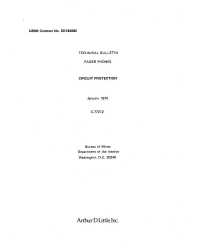Mining Publication: Technical Bulletin Pager Phones: Circuit Protection
Original creation date: January 1975
Wires leading to or from underground facilities can develop hazardous voltages because of lightning exposure. The locations of many mine portals are particularly susceptible to lightning effects. The application of protective devices to limit this potential danger is necessary. Requirement: The Code of Federal Regulations, Title 30, Mineral Resources, Part 75, paragraph 75.52 1 identifies the requirement for lightning arrestors to be used on ungrounded, exposed power conductors and telephone wires. "Each ungrounded, exposed power conductor and telephone wire that leads underground shall be equipped with suitable lightning arrestors of approved type within 100 feet of the point where the circuit enters the mine." For telephone circuits, a wide range of protective devices are available. The public service telephone companies and Rural Electrification Authority have considerable experience with the problem. The current recommendation by these organizations for such installations is to use gas-tube protectors, operating with a well-designed and constructed grounding circuit. Although pager phones are d-c systems, with signals in the audio range, many installations have coupled RF (Radio Frequency) signals on the same cable that is used for the pager system. The telephones themselves are constructed with isolating circuits, so as not to disturb RF transmission. Lightning arrestors and protective circuits must also provide this same isolation and circuit integrity for the RF signals. Capacitive protective elements cannot be used for lightning protection of such circuits, as they would short out the RF signals. Lightning strokes, either cloud-to-cloud or cloud-to-ground, release tremendous energy. The voltage associated with cloud-to-earth lightning stokes is about 5 to 20 million Volts, but the danger is in the large amounts of energy developed by the fields induced in exterior cabling. Arrestor Connection: In early telephone installations, carbon blocks of 3 mil (0.003") carbon were used as a protective breakdown device for phone circuits, but in the past ten years gas-tube devices have become more acceptable. When sufficient energy is developed between two circuits, such as a telephone line and ground reference, the protective device ionizes and provides a low-impedance path to ground, thus Arthur I3 Little, Inc keeping the hazardous voltage from reaching the remainder of the system. In a gas-tube this action takes place in a few microseconds (0.000001 second) by the ionization of gas at 1 50 to 500 Volts in a chamber, as shown below. Most installations provide a discharge path from each conductor to ground. This is the two-element system shown below. A limitation of this system is that it does not protect against energy levels that can build up between the line pair. Either of the two protective arrestors can fire on a random statistical basis with a high-energy signal applied to the line conductors. In the short time before the second arrestor operates, a large energy potential can be present between the line pair conductors. To offset this condition, the three-element system was developed. The first approach was to provide three separate arrestors as shown below. This scheme is somewhat successful, but retains the problem of significant time delays before all potential paths are closed to the buildup of energy to a danger level. A scheme to improve on this deficiency is to include all gaps within one enclosure so that when any gap is ionized the other two will benefit from a preionization and reduce the time to complete all circuits as the energy differential increases. Ground Wire: Title 30, Part 75, paragraph 75.701-4 identifies that grounding wires for the type of cable used in telephone systems (less than #6 AWG) shall be at least the same cross-sectional area as that of the conductor cable. Good installation practices dictate that the choice of ground cable for this application be at least #14 AWG solid copper. Steel or other conductor may be used if the equivalent conductivity is at least equal of # 14 AWG copper (2.5 ohms/ 1,000 feet). The protective circuit should be connected close to the point of entry into a building or below ground, and in any case not more than 100 feet from where the circuit enters the mine. Ground reference should be at a short distance from the protective circuit. Ground can be a good electromechanical bond by direct connection to a metallic water pipe leading underground, or to a buried metal stake. A 314-inch-diameter, 8-foot-long copper rod, buried vertically so that the top is 18 to 24 inches below the top surface, is normal practice to ensure a solid electrical ground reference.
Authors: Arthur D. Little, Inc.
Contract/MOA Report - January 1975
NIOSHTIC2 Number: 20031847
U.S. Department of the Interior, Bureau of Mines, Contract No. S0144082, 1975 Jan; :1-7
See Also
- Development of a Visual Display and Control System
- Experience with an Integrated, Computer-Controlled Communications and Monitoring System at the Robena Mine
- Medium-Frequency Propagation in Coal Mines
- Mine Communications and Tracking Glossary
- Technical Bulletin Pager Phones: Installation
- Through-The-Earth Wireless Real-Time Two-Way Voice Communications
- U.S. Bureau of Mines New Developments in Mine Communications
- Ultra-Low Frequency Through-the-Earth Communication Technology
- Underground Mine Communications
- Underground Mine Communications (in Four Parts): 2. Paging Systems
- Page last reviewed: 9/21/2012
- Page last updated: 9/21/2012
- Content source: National Institute for Occupational Safety and Health, Mining Program


 ShareCompartir
ShareCompartir
